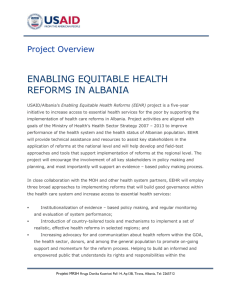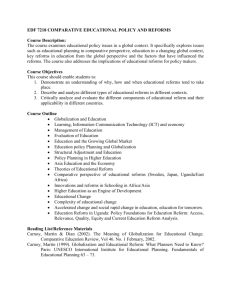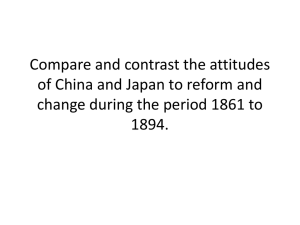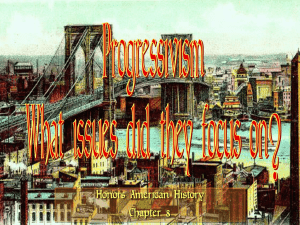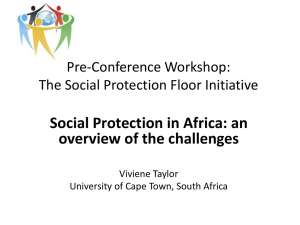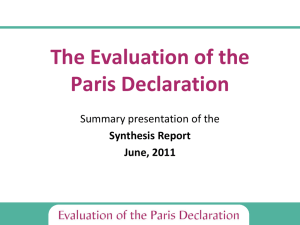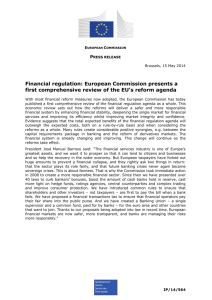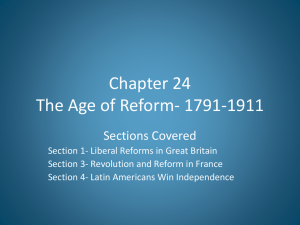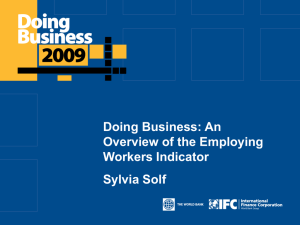Lynn Hammergren`s Presentation
advertisement
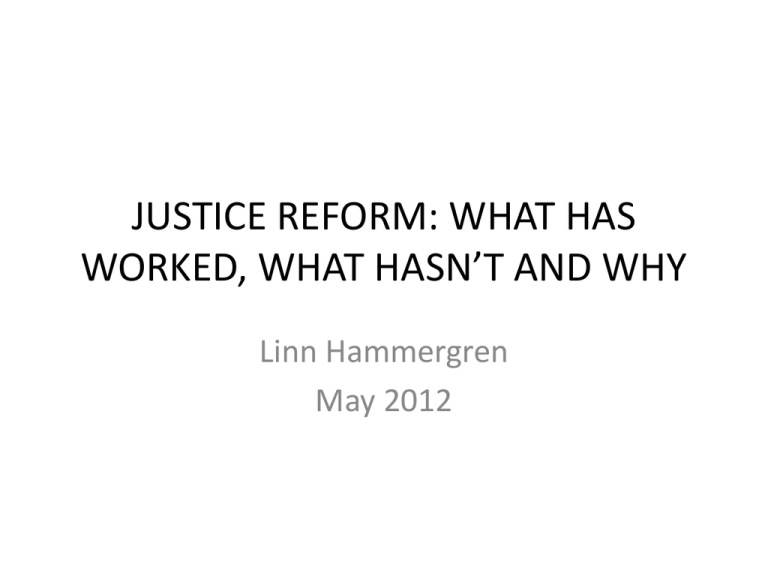
JUSTICE REFORM: WHAT HAS WORKED, WHAT HASN’T AND WHY Linn Hammergren May 2012 Overview • What is it? • How valid are the claims of failure? • Use of Berman and Fox (Berman, Greg and Aubrey Fox. 2010. Trial and Error in Criminal Justice Reform: Learning from Failure. Washington D.C.: The Urban Institute Press)on “reasons for failure,” to discuss problems • Looking ahead What is it? • • • • Problem begins here – over past two/three decades both names and meanings have varied. From Administration of Justice, to Rule of Law, to Law and Justice Reform, to legal empowerment, to ….? Also within each iteration, different visions, objectives, strategies: pro-poor, proeconomic growth (or for some pro-business), criminal versus civil justice, bottomup vs. top-down, thin versus thick model, and so on. Will focus where movement started – making formal justice institutions provide their basic services (dispute resolution, law enforcement, strengthening of legal framework shaping public/private actions) better (more efficiently, effectively, honestly, and accessibly) as part of a wider system for performing these functions. Contributes to other more ambitious ends, but is far less than what they seek. Three reasons for narrower definition: – Defective service provision was/is a problem in itself and for impacts on other societal goals – This effort is what critics say has failed; and part of why they call for other objectives, strategies. – Real questions as to feasibility of others, at least for donors or others working with short to medium-term programs. • Leave attention to other definitions for a few comments at end: here question is what happened to the simpler, initial version. So, was it all a disaster? • As with Law and Development, claims of absolute failure somewhat exaggerated • Donor-supported and national reforms over the past 3 decades have produced some positive changes: – More attention to sector – More resources for sector – Some positive innovations/changes in aspects of performance; and a few countries with greater success – A good deal of knowledge about the sector – but not well used as yet. • However, accomplishments fall far short of promises, and promises undoubtedly were always too ambitious --L. Pasara – what took 200 years to produce will not be changed in 5. • Much change, less improvement – but a base on which to build • Still, if compare with situation in 1980, hard to say nothing improved –it just did it more slowly, less completely, and with fewer of the downstream impacts than had been promised. Question: why didn’t we achieve more? Berman and Fox on reasons for failure • Four reasons – – – – Bad idea Poor implementation Politics Lack of reflection • While they are describing citizen security, applicable to all reforms, and especially pertinent here. • Not that reforms didn’t work, but could have worked better and the question is “how?” Bad Ideas • • • • • • • • There are some of these (e.g. better buildings mean better justice), but the issues are more nuanced – how ideas were applied and combined. Reductionism – “the problem was” the law, the lack of training, or even worse, USAID in ES, the absence of a forensics lab and a judicial protection unit. Formalism – and not only in LAC (ECA criticism of reliance on changing laws and structures) Failure to consider complementary actions needed to make primary one work (e.g. training in a vacuum). Emphasis on big choices and failure to consider the devilish details – e.g. judicial councils as opposed to MOJ administration. Cookie cutter programs – the same solution everywhere often because “assessments” are too superficial and so indicate the same problems Successful pilots that never scale up – pilots usually work better than roll-out, and also have to plan latter “Evidence based” methods w/o evidence – nothing is impossible but magical thinking or simply extrapolating from one “success” is dangerous. The case of bottom-up strategies? Sherman – just because you want it to work, doesn’t mean it will. Poor implementation • • • • • • • • Overlaps with above but some differences Many programs confuse means with ends – “implementing a new procedural system” as opposed to reducing certain HR violations, closing more cases within a reasonable time, etc. Academics don’t help with their zero-sum choices focusing on structures (yes, council; no, no council) and on what can’t be easily changed (party system for example) No baseline and no results specified – absolute inattention to need to include both Holistic programs out of sequence – Guatemala with buildings and equipment first and studies and plans last. Do what is easy, not what is critical and strategic. And once the judges get the goodies, they have little reason to change their work habits. Reforms need leverage. Disregard for quality of input-providers. Every IT firm is not an expert in CMS; an expert in whatever in a single country is not necessarily a good source for how to implement in another (example, German notary in Kazakhstan). Project managers w/o sufficient background in material. The manager who asked for a court administrator to do an administrative law! Redundant exercises – different donors or NGOs putting in similar inventions. Related, lack of donor coordination, lack of attention to context. Politics, a huge topic • • • • • • First of course – political will; if the leaders see no reason for reform, reform will only be symbolic or insincere. Change of leadership – that was then and this is now; the orphan reform Donor politics – donors and national governments are notoriously fickle, and constantly adding their own agendas; need of both to tout successes even when they are very limited. Donors also prefer to ignore some problems – because they are embarrassing, will create conflicts with counterparts. This undermines reforms. Bi-laterals and UN as well as MDBs (e.g. deep-sixed UN survey, WB and IADB failure to investigate corruption in construction project in LAC, UN and WB support court programs in Peru under Fujimori, Venezuela under Chavez, all donors’ editing of reports to eliminate the controversial). Any existing system has vested interests, and they will usually be better organized than the presumptive beneficiaries. Can allow “reform” to go ahead but undermine after the fact. The hardest reforms are those requiring a change in behavior, which may be why most donor programs give stuff (training, equipment, laws) but never ask for more or different work. Inadequate reflection • By this B and F mean a failure to examine reforms to see where they are going or going wrong. • Many apparently successful programs either 1) are eventually undermined or 2) produce their own negative consequences. Example of first, judicial councils; of second, the tutela/amparo in Latin America • If a reform is to continue providing positive results, may have to be tweaked along the way. This is less interesting than starting something new. • However, many programs end too quickly and only review the first stage results. Declare victory or failure and move on. Lessons for reformers • • • We have plenty of examples of all the above reasons; use them to make the next programs better. JR seems to stay at the bottom of the learning curve – constant entrance of new participants reinventing the (square) wheel and lack of attention by old-timers (because to learn from mistakes, you have to acknowledge them) We know how to do better, so why not do it? Reforms are not impossible, but won’t succeed if we can’t “learn from failures” and from successes. – Better diagnostics and better evaluations – dig deeper, look at context, admit problems – Efforts to share results: little of this between agencies, but even worse, little within. – Build expertise within organizations – no one becomes an expert in JR from a college degree, a year or two of experience, or even a career in a functioning system (R. Posner). No one becomes an expert managing from a desk, and all donor organizations seem to move in that direction, even ones like USAID that used to do better. – Recognize limits of donor expertise – what we(or our consultants) know how to do is largely technical (different from technological!). We don’t know how to build a just society or even how to define one; we do know how to run a PD system, reduce backlog; control many kinds of corruption, construct a CMS and use to monitor progress and identify problems. • New era of “bottom-up” reforms no likely to do better, and in a decade or two we will be lamenting their failure for much the same reasons – plus a novel reason; bottom-up has no historical weight behind it. Advice for the next few years • Continue with institutional reforms but do them right this time – utilize past mistakes to make improvements • Experiment with bottom-up, but make no assumptions as to success. No country has reformed this way, but perhaps it can be done. • Build expertise within donor institutions and reward the experts without insisting they “rise to management” in other areas. • Do not confuse what you want to work with more or less proven strategies. The road to hell…….
